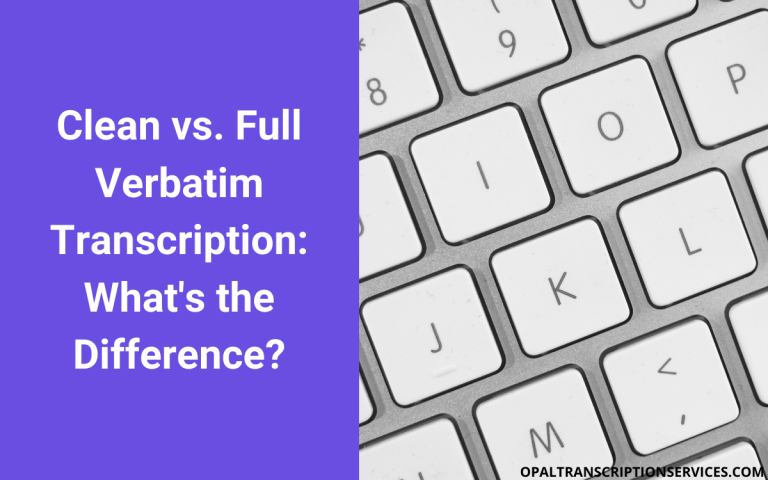Transcription Time per Audio Hour: How Long Does Transcribing Really Take?
How much time does it take to transcribe an hour of audio?
The short answer: The industry standard is four hours of transcription time for one hour of clear audio, or a 4:1 ratio – that is, one hour of transcription time for a 15-minute-long recording.
In my experience, clearly recorded audio with slow, clear speakers can be transcribed at a ratio of 3:1 or 2:1 or even lower – that’s one hour of transcription time for a 20- or 30-minute file.
And, on the other end of the audio quality spectrum, one hour of muffled or garbled audio with many overlapping voices might take 10 hours or more to transcribe.
So, we can say that one hour of audio can take anywhere from two hours to 10 hours or more to transcribe. That’s quite a range!
Because audio quality usually falls somewhere in between the two extremes, I’d guess that the ratio for many professional transcriptionists often comes out closer to 5:1 or 6:1 (five or six hours to transcribe one hour of audio).
This post may contain affiliate links. See my disclosure for more info.
Factors that affect transcription time per audio hour
Aside from level of experience and typing speed in words per minute, there are several factors that affect transcription time per audio hour:
- Audio recording quality
- Number of speakers
- Background noise
- Speaker “coherence” (i.e., do the speakers talk over each other? Do they speak quickly or slowly? Do they finish a thought before beginning the next sentence?)
- Regional accents
- Amount of research required (names, places, specialized terminology, etc.)
- Special transcript requirements, such as timestamps or true verbatim transcription
The more factors that are thrown into the mix, the longer the audio will take to transcribe. (I’ve encountered files that were entirely “un-transcribable,” but that’s a topic for another post!)
Most professional transcription services account for these factors by charging at different per-audio-minute tiers to compensate transcriptionists for the extra time it takes to transcribe a challenging file.
Or, they may charge a different fee depending on the type of audio – a podcast versus a conference call, for example. Podcasts tend to have fewer speakers and are produced with quality recording equipment, so they tend to take less time to transcribe.
Focus groups and conference calls, on the other hand, are more likely to have audio quality issues and many participants talking over each other. Therefore, they can take many more hours to transcribe.
How to decrease your transcription time per audio hour
If you’re doing your transcripts yourself to cut costs, I recommend using pro transcription software to save yourself a lot of time. (Express Scribe is an excellent free program.)
You can also use a foot pedal designed for transcription (I use the Infinity USB pedal) to control audio playback without the use of hotkeys.
If you’re working with especially challenging audio, consider using a pair of headphones “tuned” for transcription.
If you’re outsourcing your interview transcription, you’ll still want to consider the length of time your audio will take to transcribe. A challenging audio file translates into a transcript with more inaudibles, a longer turnaround time, and – if you’re working with a transcription service that compensates transcriptionists for their extra time – a higher cost.
To minimize your transcription costs and maximize your experience, use quality recording equipment and record your audio in a location with minimal noise.
For more tips on speeding up your audio and video production workflow, check out the following posts:
Are you interested in a career in transcription?
Visit my comprehensive guide on becoming a work-from-home transcriptionist. And make sure to bookmark my regularly updated list of companies that offer online transcription jobs for beginners and pros!



![6 Best AI Video Editor Tools [Ranked and Reviewed]](https://www.mondayroadmap.com/wp-content/uploads/ai-video-editors-768x480.png)

![Best Transcription Software for Audio and Video [2023]](https://www.mondayroadmap.com/wp-content/uploads/transcription-software-768x480.png)

Thank you. I am a professional transcriptionist, just recently expanding from medical and Med-Legal transcription, which bils differently, to more general transcription. I wanted to check myself and be sure my time is fairly billed to my clients compared to my actual transcription time. Your information provided was very helpful.
Hi Stephanie,
My background is also in medical transcription, and you’re correct — transcripts are typically billed per line in the MT industry. I prefer per-audio-minute pricing, because that way the client and I know up front what the final cost is going to be. Makes it easier all around! I’m glad you liked the article.
Hi Chloe I am a Medical Transcriptionist as well . I worked in house of a few hospitals but know I wanted to do some remote work, could you refer me with some possible companies?
Hi Liz,
I’m not sure where you’re located, but off the top of my head, I can think of Terra Nova, SwiftCharts, Athreon, and M*Modal for Canadian medical transcriptionists. (Athreon and M*Modal also hire in the U.S.)
For American MTs, there’s Cambridge Transcriptions, AcuTrans Aloft, wordZXpressed, and probably hundreds of others.
I also know of an Australia-based company called Global Transcription Services, and I believe they hire U.S. and Canada-based MTs. I think they used to pay fairly good rates per line. Same goes for NTS Transcriptions, also based in Australia. OutSec is a UK-based company that hires internationally.
I actually have an upcoming post or two about remote transcription opportunities (general, legal, and medical), so check back in a few weeks!
hello,
I liked the article, but I am interested in this phrase: The industry standard is four hours of transcription time for one hour of clear audio, or a 4:1 ratio
where does those number come from? is there any “official” source?
thanks in advance.
Regards,
Hi Luis,
This is a great question. I wish I had an official source to point you to, but it’s more of an accepted standard that you’ll see referenced in audio transcription forums and on transcription agency websites. Because everyone has different typing speeds, it would be impossible to pinpoint a ratio that applies across the board. Some professional transcriptionists are closer to 3:1 and others may struggle to reach 5:1, but 4:1 is the most oft-quoted ratio for clear audio with one or two speakers.
Personally, I’ve transcribed at speeds of anywhere from 2:1 to probably 10:1 (ugh!), depending on the clarity of the audio and how many participants are involved.
In any case, I don’t think typing speed is the most important skill for a transcriptionist, since it doesn’t affect the quality of the transcript. It’s possible to be a slow typist and an excellent transcriptionist. Strong editorial and active listening skills are far more important to do this job well.
I’m glad you liked the article!
Hi Chloe,
Great article, really helpful! I’m just starting out and trying to figure out a pricing structure. Does the 4:1 ratio include proofreading the transcript before returning it to the client, or is that additional time? Do you include that in your per audio minute price, or do you charge it separately? What’s the industry standard there, please?
Thank you!
I shoot for a 4:1 ratio for clear audio files, including the proofreading, so the proofreading is included in the per-audio-minute price. For more difficult files, since they can take twice as long or longer, I charge accordingly. If the audio is very poor quality, pricing can be a challenge. In those special cases you could consider charging hourly (i.e., per hour of your time) if your client is comfortable with it.
Also in terms of audio quality, I have a limit as to what I’ll accept, because if the audio is so bad that it’s going to take me many hours to transcribe an hour, then it gets to be too expensive, either for me or for the client.
The more files you work on, the more you’ll get a feel for what to charge per audio minute. And if you get it wrong and under-charge, you can charge a bit more the next time. Your rates aren’t set in stone, so feel free to experiment until you find the sweet spot for you and your clients.
Chloe